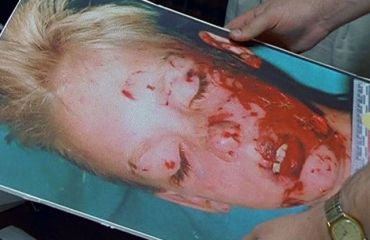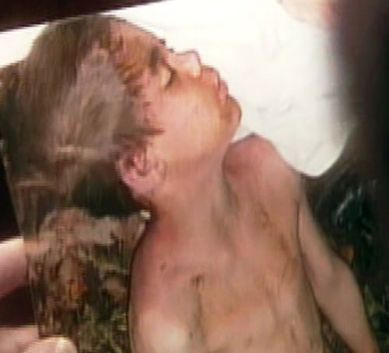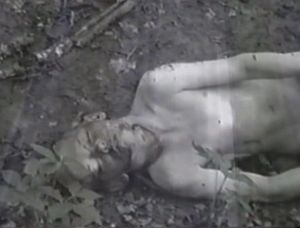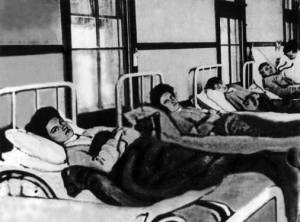We’ve heard a lot about priests and their, um, wrongdoings as of late. This particular crime occurred decades before this type of media reached the public and it went far beyond molestation, or even rape The young, bookwormish priest who committed a murder most foul certainly didn’t appear to be a cold-blooded lust killer. Then again it’s often the last person you suspect who does the damnable deed. In this case, Father John Feit , a white 27-year-old man, committed a sexually fueled murder and got away with it for an incredible fifty-five years. The now 83-year-old grandfather is in jail awaiting trial. He enjoyed 55 more years of life on earth than his pretty victim. At his advanced age, it’s quite possible that if Feit is convicted and sent to prison he may get a suspended sentence, or only serve a few, short years before dying. Sometimes there is no justice.
Irene Garza
Irene Garza was a pretty 25-year-old second grade teacher in 1960. She was also a former  beauty queen. It was easy to see why she was crowned a beauty queen. Garza had pretty brown eyes, porcelain skin, thick, curly, dark hair and a winning smile. She resembled a movie star. Needless to say, she captured many hearts in her small town and she had her pick of the best suitors. However Garza was a decent, churchgoing girl with a pristine reputation who was respected by everyone in her community.
beauty queen. It was easy to see why she was crowned a beauty queen. Garza had pretty brown eyes, porcelain skin, thick, curly, dark hair and a winning smile. She resembled a movie star. Needless to say, she captured many hearts in her small town and she had her pick of the best suitors. However Garza was a decent, churchgoing girl with a pristine reputation who was respected by everyone in her community.
Garza was the first in her family to go to college. After graduation, she returned to do what she had set out to do: teach disadvantaged children in McAllen. She taught second grade at a school south of the railroad tracks.
An old, charming letter she wrote to a friend was discovered and it offered a glimpse into this simple girl’s life: “I’ve made quite a few friends this year and am much happier than I’ve ever been.” She reported she had been dating two men but was coy with her friend about one of them: “I won’t mention his name, but we double-dated the last time you were here.” The other, she wrote without much enthusiasm, was an “Anglo boy—not real handsome, but cute and religious (which is important).” She noted that her ex-boyfriend sent her several cards and a box of candy on Valentine’s Day. “I can’t lie—I think of him often and wonder if I’ll ever get over him (between you and me and the four walls). I pray constantly that if it be God’s will, I will get over him eventually.”
 The week before Easter had been unusually hot along the Texas-Mexico border. With highs already touching the 90s, residents of the valley surrounding McAllen were predicting a long, dismal summer. Throughout the week, young adults raised in the area were streaming back to McAllen from college or new jobs. The Easter vacation was a time to see old friends, maybe even to rekindle or start a love affair. The buzz among some young men was that Irene Garza was no longer seeing Sonny Martinez. This was big news. The young men became young hopefuls, vying for her attention. Irene, as one unrequited suitor wrote, “was the closest thing to an angel” he’d ever met. “So bright, so beautiful, such a sweetheart, such a good heart.”
The week before Easter had been unusually hot along the Texas-Mexico border. With highs already touching the 90s, residents of the valley surrounding McAllen were predicting a long, dismal summer. Throughout the week, young adults raised in the area were streaming back to McAllen from college or new jobs. The Easter vacation was a time to see old friends, maybe even to rekindle or start a love affair. The buzz among some young men was that Irene Garza was no longer seeing Sonny Martinez. This was big news. The young men became young hopefuls, vying for her attention. Irene, as one unrequited suitor wrote, “was the closest thing to an angel” he’d ever met. “So bright, so beautiful, such a sweetheart, such a good heart.”
The Disappearance
On that fateful day in April 1960 Garza ironically, attended Sacred Heart Church in the Rio Grande Valley to offer her confession to Father Felt. It was the last time anyone other than Felt saw Garza alive. At first police believed Garza had probably run off with a secret lover. Perhaps they saw that type of scenario often in other cases but their line of questioning certainly wouldn’t have logically led them to that conclusion. Garza was a pious, church-going girl who still lived with her parents.
 The Murder
The Murder
Her body was eventually found in a nearby canal, beaten and showing signs of an attempted rape. The cause of death was suffocation. The Friday following Good Friday, April 1960, in McAllen, Texas. police were obliged to visit the home of Josephina and Nick Garza’s home. They delivered the worst news the couple would ever hear, that they’d finally found their beautiful daughter – dead. Josephina collapsed to her knees and wailed a sound so mournful that it became the stuff of legend in this border town. “They said it was this long, awful moan from deep inside her body — almost like the howl of a wolf…They said it was like nothing they had ever heard or would ever hear again.”
The family’s parish priest, Joseph O’Brien, comforted Josephina by telling her that Garza died in a state of grace. After all, she was last seen alive on her way to confession. The fact was, though, O’Brien had no idea if Irene ever gave her confession to Feit. O’Brien also didn’t tell the Garzas that he was confident he knew who had killed their daughter. Incredibly it was O’Brien who took Feit’s confession but wasn’t inclined to pursue the murder with police. A priest by the name of Father Dale Tacheny believed that the pastor worked in concert with McAllen police to cover up Feit’s involvement in the murder.
Suspect
Police named Feit as the prime suspect after they discovered a slide projector he purchased a few months before located just a few feet from the spot where Garza was dragged to the canal. They suspected the murderer had used the clunky machine, which had a long cord, to sink Garza’s body.
 Police found a nearly new slide projector a few feet from the spot where the young woman’s body had been dragged into the canal. After a headline story in the McAllen paper about the projector, area newspapers never mentioned this clue again. Police sought the owner of the projector and reported this to the media. Eight days after Irene’s body was found, they received this note: “This viewer belongs to Fr. John Feit (Order of Mary Immaculate), of San Juan, Texas. It was purchased in Port Isabel, Texas, in July, 1959, at Freddies Professional Pharmacy. Terms — cash. Price — I don’t remember. April 29, 1960.”
Police found a nearly new slide projector a few feet from the spot where the young woman’s body had been dragged into the canal. After a headline story in the McAllen paper about the projector, area newspapers never mentioned this clue again. Police sought the owner of the projector and reported this to the media. Eight days after Irene’s body was found, they received this note: “This viewer belongs to Fr. John Feit (Order of Mary Immaculate), of San Juan, Texas. It was purchased in Port Isabel, Texas, in July, 1959, at Freddies Professional Pharmacy. Terms — cash. Price — I don’t remember. April 29, 1960.”
Just as condemning, Feit was indicted in the attempted sexual assault of another woman at a nearby Catholic church. He pleaded no contest and was ordered to pay a $500 fine. The priest’s supervisors, the Archdiocese of San Antonio and the Order of Mary  Immaculate, shipped him off for “rehabilitation” at a series of monasteries in Texas, Iowa, Missouri, and New Mexico. This was commonplace in the Catholic church when errant priests were discovered. Not surprisingly Feit left the priesthood 10 years later. He married a young AT&T worker he met at a church in Albuquerque. In the late 1970s, Feit, his wife and three children moved to the Arcadia district of Phoenix, where the family attended the nearby St. Theresa church.
Immaculate, shipped him off for “rehabilitation” at a series of monasteries in Texas, Iowa, Missouri, and New Mexico. This was commonplace in the Catholic church when errant priests were discovered. Not surprisingly Feit left the priesthood 10 years later. He married a young AT&T worker he met at a church in Albuquerque. In the late 1970s, Feit, his wife and three children moved to the Arcadia district of Phoenix, where the family attended the nearby St. Theresa church.
Arcadia
Felt lived his life in Arcadia as though he was a model citizen. No one would have guessed that the amicable, quiet man was a murderer. For much of the time he was in Arcadia, he led charitable programs for the Phoenix chapter of the Society of St. Vincent de Paul and he helped to organize the JustFaith, an educational program designed to help Catholics use their beliefs in social justice issues.
 But in McAllen, Texas, after all the years that had passed. However due to the continued pressure from Garza’s family and friends, the authorities weren’t completely inactive in the case. Since 2014 Feit was interviewed by the police and even faced a grand jury probe in 2004, where it was decided there was insufficient evidence to have him charged. New evidence was collected which included testimony from two of Feit’s closest associates, who both stated the ex-priest confessed to them that he killed Irene Garza. Incredibly, neither of the associates turned him in. And the district attorney in south Texas didn’t want to re-try the case.
But in McAllen, Texas, after all the years that had passed. However due to the continued pressure from Garza’s family and friends, the authorities weren’t completely inactive in the case. Since 2014 Feit was interviewed by the police and even faced a grand jury probe in 2004, where it was decided there was insufficient evidence to have him charged. New evidence was collected which included testimony from two of Feit’s closest associates, who both stated the ex-priest confessed to them that he killed Irene Garza. Incredibly, neither of the associates turned him in. And the district attorney in south Texas didn’t want to re-try the case.
 Before his arrest, Feit made a direct statement to the press: “I did not kill Irene Garza.” He also stated, “I am not the man who killed Irene Garza.” There may be some truth to the latter. The man he was 56 years ago may indeed be long gone, and somehow a more respectable, or at least safer, man emerged to take his place. When asked by a reporter if he should be considered a danger to the community, he yelled: “Look at my record for the last 45 years!” That was an interesting number. He couldn’t bring himself to say the last 83 years because that would have been a lie. Irene Garza’s body was thrown in a McAllen canal on Easter Sunday, 1960, forty-five years and two months ago.
Before his arrest, Feit made a direct statement to the press: “I did not kill Irene Garza.” He also stated, “I am not the man who killed Irene Garza.” There may be some truth to the latter. The man he was 56 years ago may indeed be long gone, and somehow a more respectable, or at least safer, man emerged to take his place. When asked by a reporter if he should be considered a danger to the community, he yelled: “Look at my record for the last 45 years!” That was an interesting number. He couldn’t bring himself to say the last 83 years because that would have been a lie. Irene Garza’s body was thrown in a McAllen canal on Easter Sunday, 1960, forty-five years and two months ago.
Arrest
Booked into the Hidalgo County Jail in South Texas, he appeared frail and used a walker. He underwent a medical evaluation to see if he was fit to stand trial and was housed in the infirmary. Naturally Feit fought extradition to Texas, and lost.McAllen Texas awaits the fate of John Feit and the end of its 55-year quest for justice.
Garza has a Facebook account entitled Justice for Garza.















































 her naked calf protruded from a brush. The body was white with blue veins visible beneath the skin. She had a long, deep gash in her side from a claw, perhaps. There were more scratches along her body. Perhaps the body had been dragged. She was naked from the waist down, and except for a hoodie that was pulled up to expose her breasts, and the socks, that was all she wore. Several metres down the road from the body was her diamond-studded blue jeans. Stuffed inside the jeans was a red bra and a pair of black underwear.
her naked calf protruded from a brush. The body was white with blue veins visible beneath the skin. She had a long, deep gash in her side from a claw, perhaps. There were more scratches along her body. Perhaps the body had been dragged. She was naked from the waist down, and except for a hoodie that was pulled up to expose her breasts, and the socks, that was all she wore. Several metres down the road from the body was her diamond-studded blue jeans. Stuffed inside the jeans was a red bra and a pair of black underwear. the company his daughter kept. “She’s always been a good girl. She just got those teenage genes in her. Teenagers nowadays think they can do anything and they’re all grown up.” I’ve never heard of teenage genes in my life but apparently that explanation made sense to Nick. Catterton often lived on the run, staying at home sometimes, with friends sometimes and at other times no one knew where she was.
the company his daughter kept. “She’s always been a good girl. She just got those teenage genes in her. Teenagers nowadays think they can do anything and they’re all grown up.” I’ve never heard of teenage genes in my life but apparently that explanation made sense to Nick. Catterton often lived on the run, staying at home sometimes, with friends sometimes and at other times no one knew where she was.







